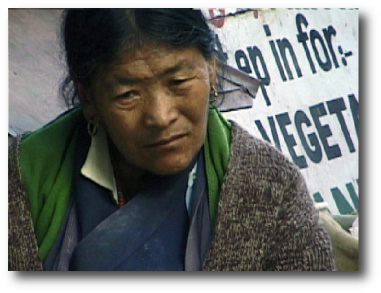* These are the keywords for the documentary:
When Buddhism was introduced from India to Tibet early in the Seventh Century A.D., Buddhism linked itself with Bon,the local religion, and became its own version of Buddhism--Tibetan Buddhism. It is often called Vajirayana Buddhism, and with Hinayana and Mahayana Buddhism,is considered one of the three main branches of Buddhism. Tibetans' lifestyle and cultural identity are largely based on Tibetan Buddhism. Once, nearly every village and town throughout Tibet featured a monastery or temple. The bigger monasteries resembled monastic cities. Commonly, Tibetan people displayed their Buddhist
altars and images in their homes.
Tibetan people lived in a unique society based on Tibetan Buddhism for more than 1,200 years. Prior to the 1950s, and for more than 350 years, the people had lived harmoniously under the spiritual and temporal leadership of the succession of Dalai Lamas, revered as the incarnation of the Buddha of compassion
(Avalokiteshvara). However, since the Chinese Communist government invaded Tibet in the 1950s, the Tibetan Buddhist society and culture have been devastated.

The Chinese Communist government has occupied Tibet since 1959, claiming Tibet as a part of China. However, according to the Legal Enquiry Committee of the International Commission of Jurists, that claim is not based on any historical evidence. On the contrary, records show Tibet has not been a part of China, but rather, autonomous. Between 1959 and 1965 the United Nations General Assembly discussed the question of Tibet on numerous occasions. Three resolutions were passed by the General Assembly condemning China's violation of human rights in Tibet and calling upon China to respect those rights, including Tibet's right to self determination. However, the Chinese government has ignored such resolutions by the United Nations. Besides,
the government has consistently refused conversations with the Dalai Lama until now though he has proposed various ideas to solve the Tibet issue.

According to many non-governmental organizations, such as Amnesty International, Refugee International, the Scientific Buddhist Association, or the International Campaign for Tibet; 1.2 millionTibetans-one-fifth Tibet's population-died as a result of China's policy. Many more have languished in prisons and labor camps as political prisoners. More than 6,000 Buddhist monasteries, temples, and other historic buildings inside Tibet were demolished over the past decades, especially during the Cultural Revolution. Since 1959, when the Dalai Lama left Lhasa, the capital of Tibet, a total of some 100,000 Tibetans have escaped over the Himalayas on foot to settle in refugee camps in India and Nepal. Many Tibetan refugees, including many unaccompanied minors, fell prey to Chinese and Nepalese border guards or to the elements. Not only has frostbite been common in the Himalayas, but so have arrest, rape,and torture. Yet, according to the 1996 World Refugee Survey by the U.S. Committee for Refugees, during 1995, 2,076 Tibetan refugees reached Katmandu, the Nepalese capital.
According to the 1996 World Refugee Survey, about 130,000 Tibetan refugees live in India and Nepal. Everywhere, refugees have encountered suspicion, commercialism, and the harsh demands of economic survival. Refugees have built several hundred monasteries and nunneries outside Tibet, which help maintain Tibetan cultural identity. The Tibetans strive courageously to persevere in maintaining their heritage and way of life. However, their ancient way of life is still facing danger. Despite the successes of a few, most monasteries are barely surviving. They lack the consistent support from their communities that they had in Tibet,because the refugees in exile struggle with subsistence and can hardly afford to support the monasteries. According to Refugees International, the 1990 average annual income of a Tibetan in India was approximately US$400. The situation has been similar in Nepal.
Despite these tough conditions, many of the first and second generation of Tibetan refugees,including the Dalai Lama himself, consistently revere Tibet as mother earth and homeland. Inspired by the Buddhist teaching, they continue to use nonviolent means in their struggle for recovering their homeland. However, many members of the third generation of exiles, born and raised in India or Nepal, hardly share the older generations' concern of maintaining the Tibetan identity. They can hardly see a specific vision for their future as Tibetan exiles. Many tend to lose patience with the nonviolent struggle; thus they simply express their nationalistic and patriotic feelings, consisting primary of strong hatred for the Chinese Communist government. They have hardly nourished their emotional and religious attachment to their lost homeland and its traditional culture of Tibetan Buddhism as did the 1st and 2nd generations. At the same time, consumer-culture attracts them. These grandchildren of exiles tend to assimilate, losing their unique cultural identity as Tibetans in daily life. Thus Tibetan Buddhism seems to increasingly give way to American-derived consumer culture in their new host countries.
P. Christian Kilinger, the author of Tibetan Nationalism (1992), describes a result of such enculturation: a prototypical Tibetan exile is "mid-twenties and raised in the large Tibetan diaspora community . . . . He has completed his secondary education, one which emphasized fluency in English . . . . He likes popular Western music, and is a fan of Rambo and Chuck Norris videos." A young refugee of the third generation, born and raised in India, recently said, "We don't
know where our future lies!" His irritated and frustrated words express the main challenge
for Tibetan identity, and articulate the subject of this documentary: How are members of
this third generation expressing their identities? How do they struggle to come to terms with ancient traditions, exile communities, host cultures, and the global market?
|
|